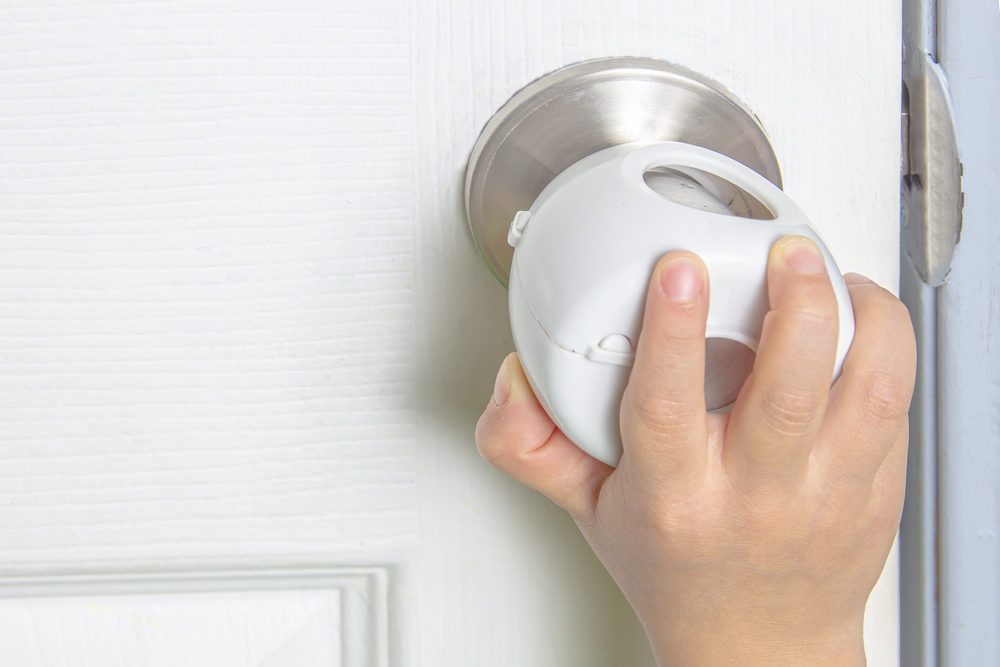 As your baby adds months and pounds, you’ll soon find yourself dealing with a toddler in possession of developing motor skills, an overwhelming sense of curiosity, and almost no ability to make good judgments. That’s the perfect mix for accidents, especially when they figure out how to operate doors. In fact, many children learn the basic principles of door operation as young as thirteen months old. At that point, all bets are off; any knobs and handles their tiny, pudgy hands can reach will be fair game.
As your baby adds months and pounds, you’ll soon find yourself dealing with a toddler in possession of developing motor skills, an overwhelming sense of curiosity, and almost no ability to make good judgments. That’s the perfect mix for accidents, especially when they figure out how to operate doors. In fact, many children learn the basic principles of door operation as young as thirteen months old. At that point, all bets are off; any knobs and handles their tiny, pudgy hands can reach will be fair game.
Before you know it, your child will possess enough autonomy to access the doors of perception on their own, which is fine, until they start accessing regular doors too. Once they figure out doors, it’s just a matter of time before locks become child’s play to them as well. It only takes a minute for a toddler to open your front door and wander out into the world to face unknown terrors, open the garage interior door for a tetanus sandwich in dad’s woodworking kitchen, or open your bathroom door and fall face-first into the litterbox mere moments after Mr. Spiffums goes #2.
Suffice to say, there’s not much time to waste. While your little tot is docile – and more importantly, immobile – you should get to work childproofing your home’s doors, both interior and exterior, to prevent any crying episodes, injury, or worse caused by unauthorized and unsupervised door use and we at ETO have prepared a list of childproofing methods that should do the trick.
Interior Doors
To keep small children out of rooms where they might encounter hazards, or to prevent them from getting stuck in rooms with lockable doors, try these childproofing solutions:
Top Lock
Top locks are fitted to the tops of doors, and like many childproofing solutions, they exploit a toddler’s greatest disadvantage: height. Or lack of it. Locking the door directly to its frame, a top lock is accessible by adults on either side of the door. Top locks can be made of plastic or metal, but it’s always best to opt for metal, since plastic locks will eventually break with enough force. Installation is quick and straightforward.
Door Monkey
The door monkey is a door knob attachment that holds a door in place while keeping it ajar. It also allows air circulation. If you’re concerned your child is going to injure themselves by getting hands, fingers, or other extremities stuck in a closing door, or if you have older children who will be able to navigate such a device, the door monkey might be for you. Plus, small pets will have an easy time getting in and out, and the door monkey conveniently hangs on the knob when not in use.
Pressure Unlock Knob
You might want to change your door hardware entirely, opting instead for hardware with a pressure unlock system. Pressure unlock systems make use of a lock release mechanism accessed on the outside of a lockable door. This affords privacy when needed, but also allows the door to be unlocked in case of emergencies. The lock release can be triggered by inserting a paperclip or similar thin prodding object into a pinhole on the outer door knob.
Exterior Doors
Busy streets, balconies, and pools all pose a danger to toddlers who manage to open an exterior entry door, so make sure these doors are fitted with additional safety measures that make opening them more difficult or impossible for toddlers.
Door Knob Cover
To prevent children from turning door knobs with ease, you can attach door knob covers. Like the tops of childproof medicine containers, door knob covers drastically increase the difficulty involved in opening a door. Door knob covers employ a variety of different mechanisms to accomplish this, but they are almost all designed to be semi-permanent solutions, meaning you won’t have to continue to remove and replace the door knob cover. It can be left installed as long as it’s necessary.
Deadbolts
An additional deadbolt can be installed in most entryway doors. Like the deadbolt built into your primary door hardware, this deadbolt secures the door slab to its frame. Unlike the primary deadbolt, a childproofing deadbolt is not usually able to be manipulated from outside the door, and is placed high enough on the door so as to be out of the reach of small children.
Security Chain
Like a top-mounted deadbolt, a security chain placed high enough on a door will usually be enough to prevent small children from opening the door. Always make sure deadbolts and security chains will still be inaccessible even if small children stand on a chair or stepladder to reach them. Which they will.
Flip Locks
When you want to childproof sliding glass doors, flip locks are your best friend. Extremely simply in construction and installation, flip locks continue the trend of relying on a toddler’s lack of reach to prevent the unsupervised use of doors. When put in the lock position, flip locks physically block sliding doors from opening.


